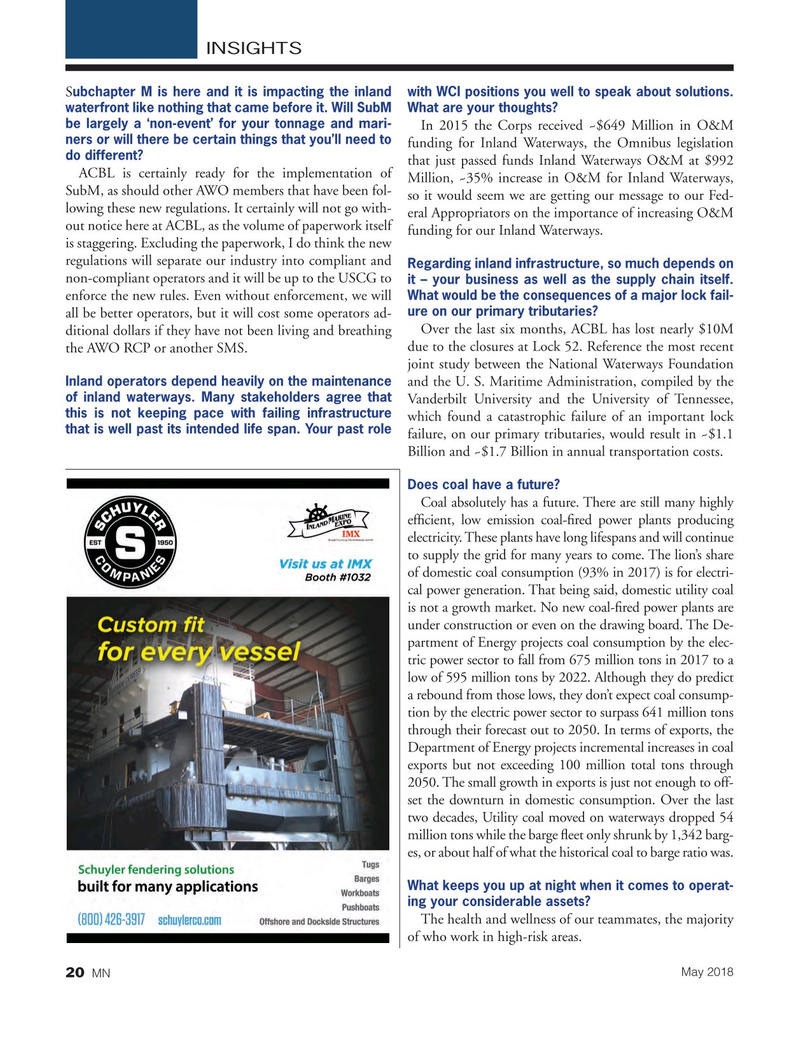
Page 20: of Marine News Magazine (May 2018)
Inland Waterways
Read this page in Pdf, Flash or Html5 edition of May 2018 Marine News Magazine
INSIGHTS
Subchapter M is here and it is impacting the inland with WCI positions you well to speak about solutions. waterfront like nothing that came before it. Will SubM What are your thoughts?
be largely a ‘non-event’ for your tonnage and mari-
In 2015 the Corps received ~$649 Million in O&M ners or will there be certain things that you’ll need to funding for Inland Waterways, the Omnibus legislation do different?
that just passed funds Inland Waterways O&M at $992
ACBL is certainly ready for the implementation of Million, ~35% increase in O&M for Inland Waterways,
SubM, as should other AWO members that have been fol- so it would seem we are getting our message to our Fed- lowing these new regulations. It certainly will not go with- eral Appropriators on the importance of increasing O&M out notice here at ACBL, as the volume of paperwork itself funding for our Inland Waterways.
is staggering. Excluding the paperwork, I do think the new regulations will separate our industry into compliant and
Regarding inland infrastructure, so much depends on non-compliant operators and it will be up to the USCG to it – your business as well as the supply chain itself. enforce the new rules. Even without enforcement, we will
What would be the consequences of a major lock fail- ure on our primary tributaries?
all be better operators, but it will cost some operators ad-
Over the last six months, ACBL has lost nearly $10M ditional dollars if they have not been living and breathing due to the closures at Lock 52. Reference the most recent the AWO RCP or another SMS. joint study between the National Waterways Foundation
Inland operators depend heavily on the maintenance and the U. S. Maritime Administration, compiled by the of inland waterways. Many stakeholders agree that
Vanderbilt University and the University of Tennessee, this is not keeping pace with failing infrastructure which found a catastrophic failure of an important lock that is well past its intended life span. Your past role failure, on our primary tributaries, would result in ~$1.1
Billion and ~$1.7 Billion in annual transportation costs.
Does coal have a future?
Coal absolutely has a future. There are still many highly ef? cient, low emission coal-? red power plants producing electricity. These plants have long lifespans and will continue to supply the grid for many years to come. The lion’s share of domestic coal consumption (93% in 2017) is for electri- cal power generation. That being said, domestic utility coal is not a growth market. No new coal-? red power plants are under construction or even on the drawing board. The De- partment of Energy projects coal consumption by the elec- tric power sector to fall from 675 million tons in 2017 to a low of 595 million tons by 2022. Although they do predict a rebound from those lows, they don’t expect coal consump- tion by the electric power sector to surpass 641 million tons through their forecast out to 2050. In terms of exports, the
Department of Energy projects incremental increases in coal exports but not exceeding 100 million total tons through 2050. The small growth in exports is just not enough to off- set the downturn in domestic consumption. Over the last two decades, Utility coal moved on waterways dropped 54 million tons while the barge ? eet only shrunk by 1,342 barg- es, or about half of what the historical coal to barge ratio was.
What keeps you up at night when it comes to operat- ing your considerable assets?
The health and wellness of our teammates, the majority of who work in high-risk areas.
May 2018
MN 20
MN May18 Layout 18-33.indd 20 MN May18 Layout 18-33.indd 20 4/20/2018 10:04:52 AM4/20/2018 10:04:52 AM

 19
19

 21
21
